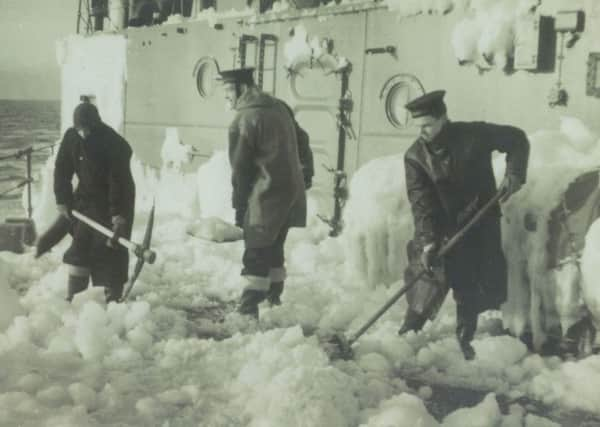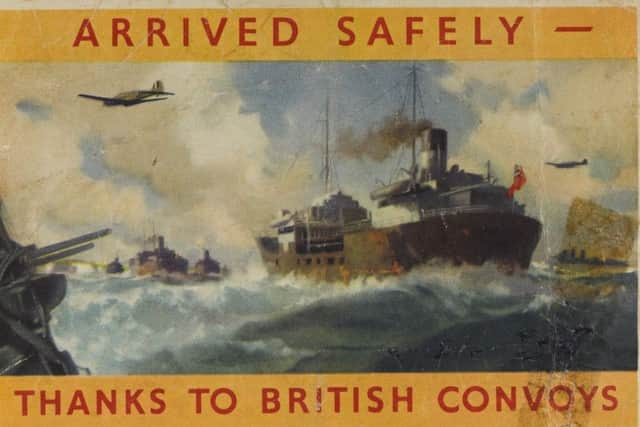The part these South Shields sailors played in the Second World War


As the SS River Afton began to sink, writes Dorothy, one of the men, Benjamin Coffey, of Marshall Wallis Street, found himself in trouble as he was being dragged down towards the sea bed.
“My lungs felt as though they were bursting,” recalls Benjamin, “and I thought I was going to lose consciousness, but the boilers exploded and this helped me to reach the surface again.
Advertisement
Hide AdAdvertisement
Hide Ad

“I had only learned to swim when I was 16, but I was jolly glad I did for it came in handy that night! I reached a raft which was about 25 yards away and managed to get aboard.”
The sea was filled with ship’s debris and men fighting desperately to stay alive, reveals Dorothy.
Fellow South Shields seaman, Chief Steward Percy Grey, was freezing in the icy waters.
“We had been left behind by the convoy,” explained Percy later, “and a German submarine surfaced and asked us the name of our ship, our destination and our cargo. Some of the men shouted to the commander and asked him to take some of our injured men aboard.
Advertisement
Hide AdAdvertisement
Hide Ad

“The German replied that he could not, that war was war. He gave a bottle of wine and a bottle of water to some men who were clinging to an upturned lifeboat and told us the direction in which to steer to the nearest land.”
The submarine and its commander, Heinz Bielfeld, then disappeared under the surface.
Percy struggled in the water for about 30 minutes before managing to get to a raft and climb on.
His limbs must have been numb, comments Dorothy.
“It seemed as though I had been in the water for days,” added Percy afterwards, “for we were in the far north regions and the sea was agonisingly cold. My feet were affected by being in the water so long and they still trouble me a little.”
Advertisement
Hide AdAdvertisement
Hide AdDespite getting onto the raft (which had no compass or food on board and few paddles), Percy did not hold out much hope of being seen by another ship, but miraculously after about four hours, he was picked up by The Lotus.
Percy and some of the other bedraggled survivors were later landed in Russia and, after recuperating, he was put aboard a convoy bound for England.
“It was not a voyage without incident,” reveals Dorothy, “as they were attacked incessantly by the enemy all the way home.
“Three more of the ship’s crew were killed returning to Britain.
Advertisement
Hide AdAdvertisement
Hide AdChief Steward Grey, who up to this date had already been on two convoys to Russia, brushed aside the terrifying events he’d been through by saying: “They were only what were to be expected when going to sea”
An understatement, said Dorothy, if ever there was one!
Percy was later awarded the George Medal for his courageous actions that day and also the Lloyds War Medal.
Benjamin Coffey, who was born in Shields in 1917, and educated at Laygate Lane School until he went to sea at the age of 15, was awarded the Order of The Red Star by Russia for his gallantry on the River Afton.
It is believed he was the first Englishman to receive it.
The honour also included an annuity and some privileges in Russia, such as a certain number of free railway journeys during the year.
Advertisement
Hide AdAdvertisement
Hide AdFor his part, Benjamin was extremely honoured, saying at the time: “I would like to thank the Russian people for the kindness they had shown when I was landed in their country”.
He was also congratulated by Rear Admiral Kharlamov, Naval attaché to the USSR Embassy.
On the day that River Afton was lost, the SS Pan Kraft, Washington, Carlton, Honomu, Empire Byron and SS Paulus Potter also sank, while the Peter Kerr caught fire and was abandoned.
In 1943, the Soviet Ambassador in London expressed the gratitude of his country to the men on the Arctic convoys, saying: “This saga will live for ever, not only in the hearts of your people, but also in the hearts of the Soviet people, who rightly see in it one of the most striking expressions of collaboration between the Allied governments, without which our common victory would have been impossible.
Advertisement
Hide AdAdvertisement
Hide AdPQ17’s cargo was worth $700 million and included 300 aircraft, 600 tanks, 4,000 lorries and trailers and a general cargo of more than 150,000 tons, enough to equip an army of 50,000. Only 11 of its 35 merchant ships survived the German attacks.
Between August 1941 and May 1945, 78 convoys made this perilous journey carrying four million tons of supplies to the Soviets fighting the Nazis on the Eastern front.
The total deliveries included 7,000 aeroplanes, 5,000 tanks, cars, fuel, medicines, outfits, metals and raw material.